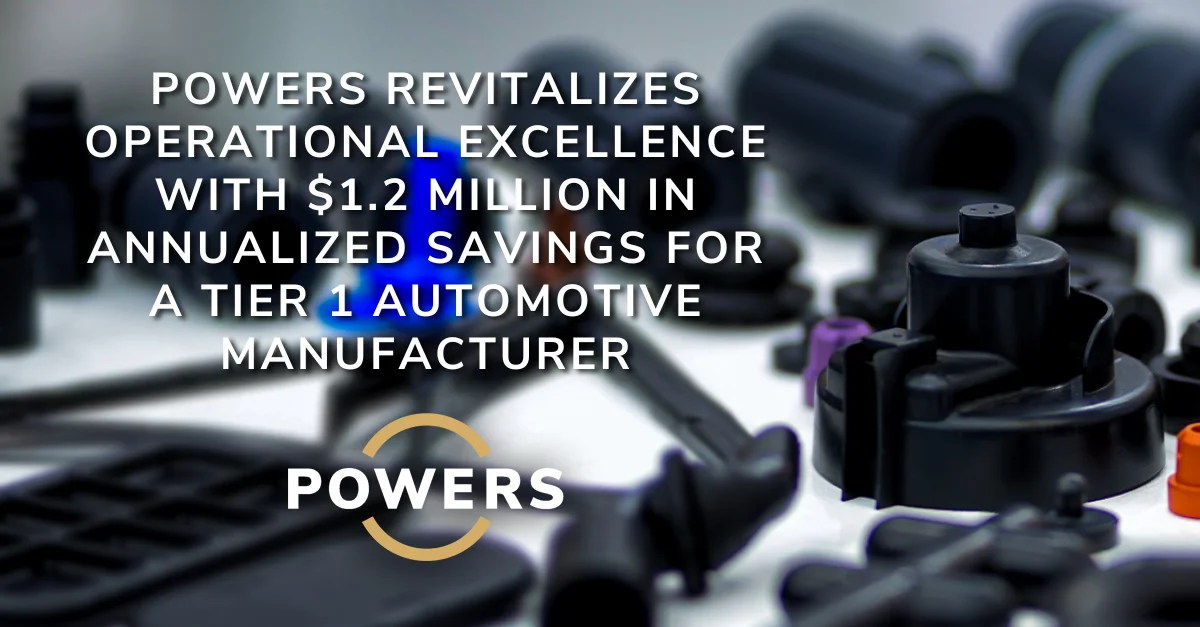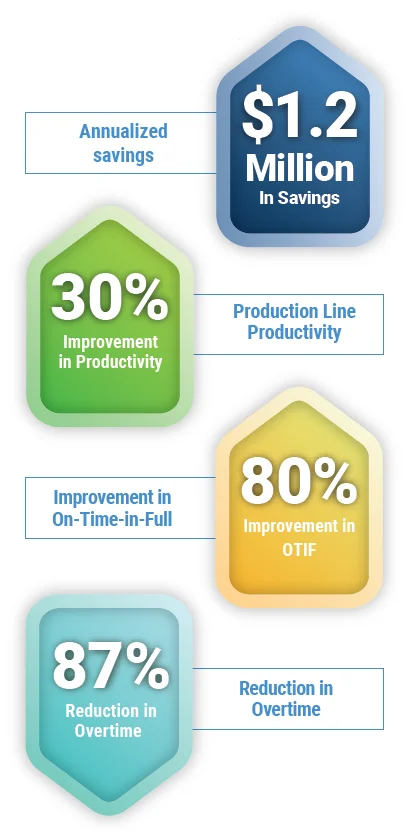

Project Overview

Performance Results
Situation
In the competitive landscape of automotive manufacturing, success hinges on not only meeting customer demands but also maximizing operational efficiency. At POWERS, we recently partnered with a Tier 1 automotive manufacturer specializing in blow and injection mold parts, a company that boasts a rich history as a key player in the industry.
Established in 2005, this manufacturer has served as an onsite supplier for some of the world’s largest car manufacturers, earning recognition for its dedication to supplier diversity and its commitment to fostering inclusive environments that stimulate innovation. However, even seasoned industry leaders are not immune to the challenges that can disrupt their operations.
This case study delves into the journey of a company that, despite its pedigree, was confronted with a series of operational obstacles that threatened its profitability. The fluctuations in demand, labor issues, and pandemic-induced supply chain disruptions had a significant impact, leading to financial losses. Our client sought our expertise at POWERS to navigate these treacherous waters to optimize operational performance to meet actual capacity, enhance customer satisfaction, and drastically reduce excess overtime.
The outcome of this partnership was nothing short of successful. By collaborating with POWERS, our client managed to accelerate its performance to unprecedented levels. Through a strategic approach and tailored solutions, they achieved a remarkable 30% boost in productivity, an impressive 80% improvement in on-time-in-full (OTIF) metrics, and a staggering 87% reduction in overtime.

Analysis
The automotive company's management relied on historical performance data from other plants, which concealed production waste and lost time. This approach negatively impacted schedule attainment, on-time-in-full (OTIF) metrics, excess labor hours, and profit visibility. Moreover, a lack of skills development and high turnover led to critical skills erosion among the workforce. Daily "firefighting" took precedence over structured performance improvement efforts. Insufficient communication and alignment between departments resulted in ineffective production line startups.
The absence of predictive or preventive maintenance procedures led to reactive maintenance practices, causing significant unscheduled downtime. Frontline managers operated with expectations set below their actual capabilities, further hampering performance. Lastly, the organization lacked the management processes, disciplines, and skills to foster a proactive, initiative-taking, performance-based culture. Upon POWERS’ intervention, key problems were identified:
- Operating based on historical performance rather than actual capacity.
- Eroding critical skills within the workforce.
- Frontline supervisors overwhelmed by daily firefighting.
- Lack of essential information for decision-making.
- A performance gap across multiple departments.
- Ineffective production line startups.
- Reactive maintenance leading to unscheduled downtime.
- Unrealistic expectations set for frontline managers.
- Insufficient investment in developing a performance-based culture.
The Plan:
To tackle our client's multifaceted challenges, POWERS designed and executed a comprehensive strategic plan. This plan incorporated a range of initiatives aimed at optimizing the company's operational performance:
- Establishing Cross-Functional Partnerships: We fostered collaboration between various departments, breaking down silos to create cross-functional performance partnerships. This initiative improved communication and execution, particularly during crucial plant startups, ensuring smoother and more efficient operations.
- Standardizing Startup Routines: We developed standardized startup routines to minimize downtime and reduce operator errors. These procedures provided a structured framework for operations, promoting consistency and reliability throughout the manufacturing process.
- Addressing Skills Gaps: Recognizing the critical importance of a skilled workforce, we identified and addressed skills gaps among frontline leaders and the broader workforce. Our training and development programs were tailored to bridge these gaps and enhance overall competence.
- Calculating Actual Production Capacities: A key step in our plan was calculating the actual production capacities of the business. This data-driven approach allowed us to set realistic performance expectations, aligning operations with achievable targets.
- Supervisor Training and Coaching: Frontline supervisors play a pivotal role in daily operations. We invested in their growth by providing comprehensive training, coaching, and ongoing support. This empowered them to execute new performance standards and effectively align with the company's vision.
- Equipping Supervisors with Decision-Making Skills: Decision-making is crucial to daily performance. We equipped frontline supervisors with the necessary decision-making skills to respond proactively to operational challenges and opportunities.
- Identifying and Eliminating Ineffective Processes: Our plan thoroughly examined existing processes. We streamlined operations by identifying and eliminating ineffective practices contributing to waste and lost time, improving efficiency and productivity.
This comprehensive strategy aimed to address the root causes of the company's challenges, fostering a culture of continuous improvement and performance excellence. Through a combination of collaboration, training, data-driven decision-making, and process optimization, our plan empowered our client to not only overcome obstacles but also achieve remarkable results.
Results
Our strategic efforts yielded exceptional results, driving a true transformation in the operational landscape of our client's Tier 1 automotive manufacturing facility. These results exceeded expectations and underscored the potency of a well-crafted strategy and the collaborative spirit of our partnership.
- 30% Productivity Surge: The heart of this transformation was a remarkable 30% increase in overall productivity. Several production lines soared to new heights, achieving astounding improvements, with some registering over a 50% increase in efficiency. This productivity surge met the company's goals and demonstrated the untapped potential within its workforce and operations.
- 80% OTIF Enhancement: One of the key performance metrics, On-Time-in-Full (OTIF), witnessed an impressive 80% enhancement. This outcome underscored the successful alignment of operational processes and the renewed focus on meeting customer demands promptly and accurately. Our client's commitment to excellence in delivery was revitalized.
- 87% Reduction in Overtime: The strategic interventions led to an astonishing 87% reduction in overtime. This reduction contributed to cost savings and signified a more balanced and sustainable workload for the workforce. It showcased a shift from reactive firefighting to proactive planning and execution.
- 1.2 Million Saved in 16 Weeks: The financial benefits of this transformation were substantial. Projected annualized savings, which exceeded an impressive 1.2 million USD, were realized within a remarkably short span of just 16 weeks. These savings underscored the impact of our strategic initiatives on the bottom line, reinforcing the organization's financial health.
The increased cohesion among teams fostered a more harmonious work environment. Enhanced engagement levels among employees were palpable, reflecting a renewed sense of purpose and commitment. Frontline leaders emerged as better-trained and more capable individuals, ready to drive continuous improvement.
By implementing a strategic plan, this Tier 1 automotive manufacturer overcame its operational challenges and set a course for sustained growth and profitability. With a revitalized operational foundation and a workforce primed for success, the organization stands poised to navigate future challenges with confidence and continued excellence





